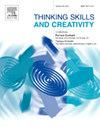在STEAM综合竞赛中探索艺术作品的价值
IF 4.5
2区 教育学
Q1 Social Sciences
引用次数: 0
摘要
随着STEAM (Science, Technology, Engineering, Art, and Mathematics,简称iSTEAM)教育的整合,相关的竞赛也越来越多。本研究以台湾每年举办约25年的iSTEAM-PowerTech竞赛为例,学生以团队形式在现场制作木质仿生微型模型,并在造型美学和速度方面进行比赛。本研究通过在学生的微型模型创作中加入艺术作品来检验艺术在STEM中的重要性。本研究选取获得iSTEAM-PowerTech艺术奖的5名学生代表和5名教师,通过观察、访谈和文献分析等方法,对相关资料进行收集、整理、分析和解释。结果发现,在STEM中加入艺术品时:(1)艺术品与身体的契合度是关键,艺术品的大小、重量、对称性、平衡性和稳定性影响着微缩模型的移动性;(2)学生在为速度竞赛(如接力赛)制作微缩模型时,学习兴趣、创造性思维和审美素养有所提高,认为艺术品能够促进STEM知识的学习;(3)学生们认为在为微型模型创作艺术品时遇到的困难和问题较多,因为将艺术与STEM相结合需要系统的思考和不断的修改。本文章由计算机程序翻译,如有差异,请以英文原文为准。
An exploration of the value of artwork in an integrated STEAM competition
With the integration of STEAM (Science, Technology, Engineering, Art, and Mathematics, or iSTEAM for short) education, there has been an increase in the number of related competitions. This study takes as an example the iSTEAM—PowerTech competition that has been conducted annually in Taiwan for approximately 25 years, in which students work in teams to create a wooden bionic miniature model on site and compete in terms of modeling aesthetics and speed. This study examined the essentiality of art in STEM after adding artwork to students' creation of miniature models. A qualitative study was conducted to collect, organize, analyze, and interpret relevant data through observation, interviews, and document analysis by selecting five student representatives and five instructors who won the Artwork Award in iSTEAM—PowerTech. The results found that when art was added to STEM: (1) The fit between the artwork and the body was key, and the artwork's size, weight, symmetry, balance, and stability affected the miniature model's mobility; (2) Students' interest in learning, creative thinking, and aesthetic literacy increased when making miniature models for the speed competition (e.g., relay racing), and they believed artwork was able to promote their STEM knowledge learning; and (3) Students thought they encountered more difficulties and problems when creating artwork for miniature models, because it required systematic thinking and continuous revision to integrate arts with STEM.
求助全文
通过发布文献求助,成功后即可免费获取论文全文。
去求助
来源期刊

Thinking Skills and Creativity
EDUCATION & EDUCATIONAL RESEARCH-
CiteScore
6.40
自引率
16.20%
发文量
172
审稿时长
76 days
期刊介绍:
Thinking Skills and Creativity is a new journal providing a peer-reviewed forum for communication and debate for the community of researchers interested in teaching for thinking and creativity. Papers may represent a variety of theoretical perspectives and methodological approaches and may relate to any age level in a diversity of settings: formal and informal, education and work-based.
 求助内容:
求助内容: 应助结果提醒方式:
应助结果提醒方式:


